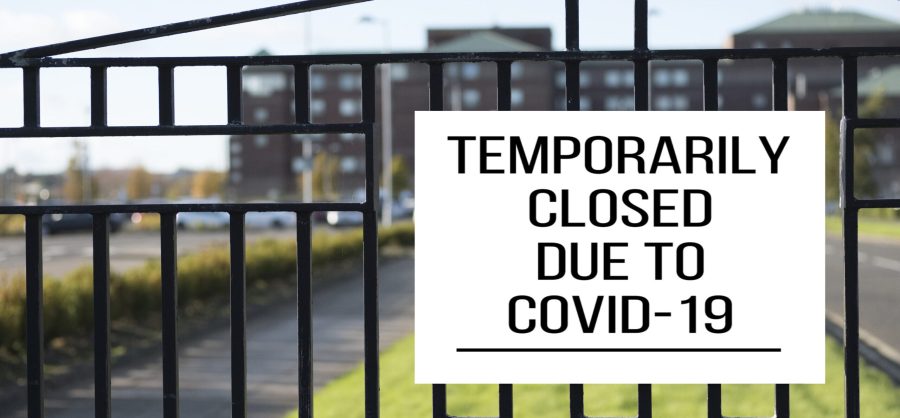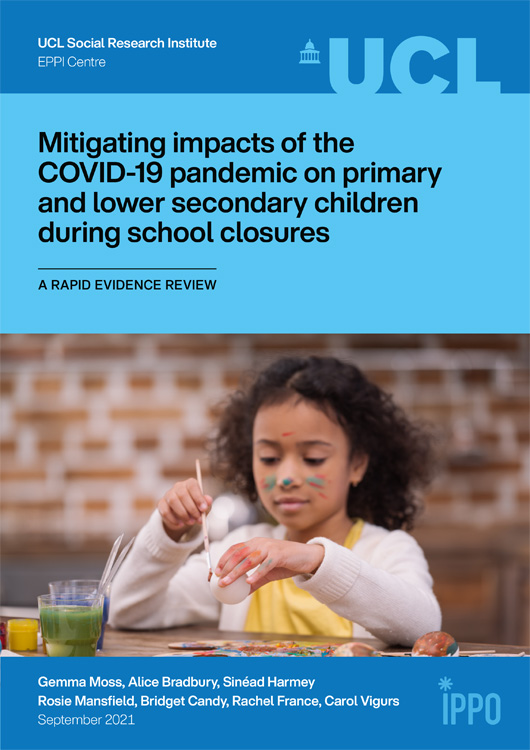IPPO Rapid Evidence Review: The impact of UK school closures on children during the COVID-19 pandemic

This review was commissioned by the UK Government’s Department for Education (DfE) following a recommendation from the Scientific Advisory Group for Emergencies (SAGE). It was managed by the EPPI-Centre at UCL; click here for the full review
- IPPO Rapid Evidence Review summaries: Schools / FE / HE / Parents & carers
Summary of findings

IPPO’s Rapid Evidence Review into the impact of COVID-related school closures on UK children of all school ages synthesises 65 studies on the harms relating to the closure of UK primary and secondary schools (Reception to Year 11) during the COVID-19 pandemic and eight systematic reviews of mitigation strategies, including one by two of the review authors which considers existing data on recovery from unscheduled school closures following disasters such as earthquakes and hurricanes.
The review highlights important considerations for the future of school learning and children’s wider wellbeing during the COVID ‘recovery’ period and beyond. It also asks whether the wider social value of schools within communities needs to be better measured and communicated.
The impact on children’s learning
Impacts on children’s learning stemmed from:
- The differences in time spent learning at home compared to time spent learning in school;
- Differences in the quality of work completed at home;
- Lack of access to remote learning due to inequalities in access to technology.
These factors varied over time, as more resources became available to deal with periods of complete lockdown, and schools and parents adapted to the particular circumstances they faced. Some studies documented these improvements, while drawing attention to the more substantial impacts on schools with the most deprived intakes. For example:
- ‘School provision for online learning has changed radically since the beginning of the first lockdown. Over half (54%) of teachers are now using online live lessons, compared to just 4% in March 2020.’ (Montacute and Cullinane, Jan 2021)
Early evidence collected before schools reopened in June 2020 showed that learning loss was greater for younger children. Test scores from early autumn 2020 also indicated losses compared with the equivalent period in 2019, with a potentially greater impact on maths compared with reading. Yet importantly, when children were retested later in the autumn term 2020, the decline in scores was only a fifth of what it had been early in the term, indicating that children had begun to catch up once back in school. This evidence suggests that estimates of the long-term impacts on attainment need to be treated with caution.
In the short term, schools can assume that there will be greater variation in attainment in any given class, and that they can most usefully address this through high quality whole class instruction, coupled with differentiated learning activities that support specific pupils’ needs while maintaining access to a broad and rich curriculum. Assessing the range of impacts on pupils from the pandemic and how they interact will be an on-going process (Sharp and Nelson, 2021). Attempts to distinguish harms that impact in the short term from longer lasting harms may take time. It also requires schools to have access to contextually relevant diagnostic tools.
The impact on children’s mental health
Few studies included pre-pandemic comparisons of symptoms making it difficult to assess changes in mental health and wellbeing and causally attribute them to the COVID-19 pandemic. Although methodologically limited, the available evidence was mixed revealing both positive and negative effects of the pandemic on children’s mental health and wellbeing. For example, almost one third of children in one study undertaken in June/July 2020 reported experiencing better sleep (Mansfield et al., 2020), and adolescents cited the positive impacts of spending more time with their families (Waite et al., 2021).
However, a longitudinal study launched in March 2020 that followed young people and their families throughout the pandemic provided evidence that:
- Pre-adolescent children experienced greater deterioration in mental health than older children (Waite et al., 2021);
- Girls were more likely to experience difficulties than boys (Raw et al., 2021);
- Young people from low-income families and those with special educational needs and disabilities (SEND) have faced greater challenges with mental health and wellbeing (Pearcey et al., 2020).
The effects on children of increased exposure to risk factors
Evidence suggests that some children experienced increased exposure to harms due to being confined to the domestic environment and not being able to attend school. The increased risks have been compounded by the challenges experienced by safeguarding professionals in monitoring these harms.
- Harms included abuse in the home, with increased isolation for families experiencing problems with poor mental health, drug and alcohol misuse, and domestic abuse.
- There were increased numbers of calls to Childline, including a three-fold increase in counselling sessions relating to past and present sexual abuse. This resulted from a combination of increased exposure at home and also children not being able to talk to school staff.
- The impact of the pandemic on parents and carers of UK schoolchildren is considered in a separate IPPO review.
The impact on children’s physical health and nutrition
Food insecurity and declines in physical exercise were the most prominent harms identified from school closures. School closures highlighted the increasingly important role schools play in supporting children’s basic nutrition.
- There is clear evidence that families were more reliant on food banks during the pandemic; those whose incomes had been substantially hit by the pandemic became more reliant on the support schools could offer. The Trussell Trust recorded increases in demand for emergency food parcels of 81% during the first weeks of the first lockdown compared to the previous year. The Social Market Foundation reported that between March and September 2020, 16% of parents said their children had had to make do with smaller portions, skip meals or go a whole day without eating (SMF, 2020).
- Schools went to extraordinary lengths to ensure children stayed fed during the pandemic (Moss et al, 2020).
The picture regarding exercise was more mixed:
- One study showed that while some children reported undertaking less physical exercise during school closures (50% in years 8 to 10), others did more (a third of those in years 4 to 11). (Mansfield et al., 2020)
- There were fewer paediatric Accident & Emergency hospital attendances during lockdown. This was unexpected and the reasons are not yet clear.
The impact on children living in poverty
- It is clear that children living in poverty have been most affected, in particular through food insecurity and conditions triggering stress and anxiety in the home, alongside their more limited opportunities to access digital resources for learning, or indeed outside space for physical activity.
- The ‘digital connectivity gap’ between children living in the most deprived areas of the UK and the rest of the school-age population is likely to have widened educational inequalities during the pandemic and make academic recovery for these children more challenging.
- The pandemic has highlighted the critical role schools play in supporting children living in poverty – including by provision of regular meals – in helping maintain children’s mental and physical wellbeing, and safeguarding vulnerable children from domestic stresses and abuse.
Mitigation strategies
Previous research on recovery following prolonged learning disruption due to other pandemics or natural disasters shows that:
- Successful school recovery plans privilege local knowledge, and that school leaders are in the best position to identify and respond to local needs quickly.
- Recovery can benefit from relaxing the pace of curriculum delivery to allow time for children to reflect on experiences and reconnect with opportunities to socialise in school.
In the UK context, this suggests that the mitigation strategies schools themselves have put in place in response to local needs, both during the pandemic and since re-opening, are a crucial element in successful recovery. School teachers and leaders have developed the most in-depth view of the harms to children’s wellbeing and to their learning. Without harnessing their insights, centralised prescriptions for recovery may have limited value (Sharp and Nelson, 2021).
We note that the mitigations currently offered to schools by external sources, in the form of interventions, come with varying evidence of their efficacy; and as they predate the pandemic, will not have been designed with the kind of educational disruption children have experienced in mind. Without distinguishing between short and longer-term effects, this may lead to over-prescription of interventions designed for small groups of learners struggling under normal circumstances, that are difficult to scale up in the context of the pandemic.
Instead, the evidence suggests that equipping schools with the appropriate tools to diagnose needs across the spectrum of harms will be fundamental to planning efficiently and appropriately for recovery. It will also be useful in informing local decision-making on how any recovery funding should be spent.
Although the return to normal safeguarding procedures will help to mitigate increased exposure to risk factors now that schools have reopened, the evidence suggests that safeguarding should be prominent in recovery plans to support and monitor children going forward (for example, by being alert to signs of abuse). The Anna Freud Centre provides a useful guide to resources for schools to measure and monitor pupil wellbeing.
APPENDIX
Topic specialist review authors
Professor Gemma Moss (International Literacy Centre, UCL Institute of Education), Professor Alice Bradbury (Helen Hamlyn Centre for Pedagogy, UCL Institute of Education), Dr Sinéad Harmey (International Literacy Centre, UCL Institute of Education), Dr Rosie Mansfield (UCL Social Research Institute).
These authors were supported by review specialists Carol Vigurs and Dr Bridget Candy (EPPI-Centre) and Dr Rachel France (IPPO).
Notes about this Rapid Evidence Review
The UK Government’s Department for Education (DfE) funded this work following a recommendation from the Scientific Advisory Group for Emergencies (SAGE).
The work was undertaken under the umbrella of the ESRC-funded International Public Policy Observatory (IPPO) and managed by the EPPI Centre, a specialist centre in the UCL Social Research Institute which develops methods (i) for the systematic reviewing and synthesis of research evidence; and (ii) for the study of the use of this research.
Note that while school premises remained open for children of key workers during all national lockdowns, during the second national lockdown in November 2020 they were open to all children. However, children remained at home if someone in their ‘bubble’ tested positive for COVID-19.
This is one of four education-focused Rapid Evidence Reviews that IPPO is publishing today. The full list of reviews is as follows:
- The Impact of UK School Closures on Children during the COVID-19 Pandemic
- The Impact of the Pandemic on the UK Further Education Sector and its students
- The Impact of the Pandemic on the UK Higher Education Sector and its students
- The Impact of Lockdowns and School Closures on Parents and Carers in the UK
